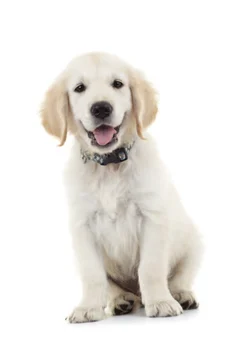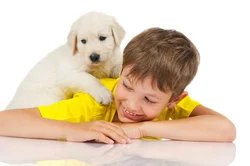Bringing Your Dog To Our Hospital
We have determined that there are 6 basic steps of “going to the vet” that can cause fear and behavioral issues in some dogs. We want to make each step a fear-free process. You can also download these tips.
Preparations For the Trip
- If your pet has had previous anxiety or fear issues when visiting our hospital, contact our office a few days prior to your scheduled visit and inquire if anxiety medication would help your dog be more calm and relaxed.
- Do not feed your dog a meal before going to the vet. If a dog has fasted, he/she will be more apt to enjoy our treats, which reduces stress. Also, if lab work is performed, a fasted sample is often preferred. If your dog has food issues, bring their favorite treats for us to use.
- Encourage your dog to defecate in the morning before you come in. If we are doing an annual exam, or your dog has GI issues, please bring a fresh stool sample (~1 teaspoon) in a baggie or collection container (we can provide if needed).
- If we are going to collect blood and urine as part of a wellness screening, it is best not to let your pet urinate immediately before coming into the hospital.
The Ride

- Use a harness or head collar to secure your dog and a good leash. If you use a flat collar, make sure the pet cannot pull itself out of that collar.
- Use a positive approach when giving commands to your dog. If you use baby talk, the pet may suspect something is up. To soothe the pet, use a matter-of-fact tone and relay instructions to your dog with confidence (e.g., “Champ, get in your crate” or “hop into the car”).
- Distract your dog with calming music. You can also select some soft classical music that offers calming qualities. This will drown out road noise that can be nerve-racking to your dog. Pet Acoustics also offers the Ultra Calmer which is a calming music collar to help calm your best friend.
- Crating small dogs during the ride is best so your pet does not accidentally get tossed around inside the car (like in wide turns or sudden stops). This can be unsettling. A cover over the sides of the crate may also help reduce the stress of the ride. Be sure to use a seat belt to hold the crate in place.
- Use ThunderEase, a calming pheromone, in the car to help reduce travel anxiety.
- Thunder shirts can also help some pets be calmer while in transit.
Entering The Hospital
- If your dog balks about coming through our doors, don’t drag them. Try using treats, toys, and verbal rewards to encourage them. Smaller pets can be carried in.
- If your dog will not enter the hospital, consider rescheduling the appointment and giving anxiety medication prior to the next scheduled visit.
- If the visit is of a more critical nature, we can also administer anxiety medication upon arrival and then wait for its full effect before proceeding.
Managing Check-In, Weigh-In, and Entering the Exam Room
- Our scales are recessed to help reduce fear with the weigh-in.
- We can use treats to help the dog settle, helping us get an accurate weight. Let us know if they need hypoallergenic treats.
- Once in the exam room, allow your dog to roam and “own” the room. Use treats to calm them. We have calming music playing to help with their comfort.
- If your pet has a favorite toy, bring it and let them play with that toy in the exam room. Familiarity can be soothing.
The Exam
- Most times a doctor and technician will enter the room together. The doctor will sit for a short time and allow your dog time to get to know him or her, and use treats to build the relationship.
- We will collect your dog’s history during this time. The technician will write up the information provided on the Pet Report Card and enter it into the computer for future reference.
- The exam will be performed where your dog is most comfortable. This can be on the floor, the bench or on the exam table. Our goal is to make this as easy for your dog as possible.
- For added comfort for your dog, our tables have a non-slip mat that is not cold to the touch.
- We use pheromone diffusers in each examination room to help calm your dog. We favor proceeding slowly during the exam to help maintain this effect.
- If your dog becomes too stressed, then a sedative, anti-anxiety medication, or even rescheduling the appointment is sometimes best. Repeated, negative experiences can cause undue stress and make the dog more reactive with their next visit. We want these to be fun and happy times for both you and your dog.
- When we have completed the exam, we will go over our findings with you. We also use that time to reward your dog with treats or a toy so they have great, lasting memories.
X-ray, Lab Sample Collection, Anal Sacs, Nail Trim, and Other Minor procedures

- If you can teach your pet to roll over and allow their tummy to be scratched, that often helps us not only with an exam but also the collection of some samples (or an x-ray, ultrasound exam).
- We use a local anesthetic cream when collecting samples to help make the process more “pain and fear-free”.
- The use of pheromone sprays and/or calming caps can also help reduce stress during this portion of the examination.
- Some dogs get extremely anxious when having minor procedures. Anxiety medication or a stronger sedative may be indicated to avoid undue mental and physical stress. We will consult with you about this step. We will not use bodily force to accomplish these tasks as that produces major problems for dogs.
Cookies on this website are used to both support the function and performance of the site, and also for marketing purposes, including personalizing content and tailoring advertising to your interests. To manage marketing cookies on this website, please select the button that indicates your preferences. More information can be found in our privacy policy here.
X

